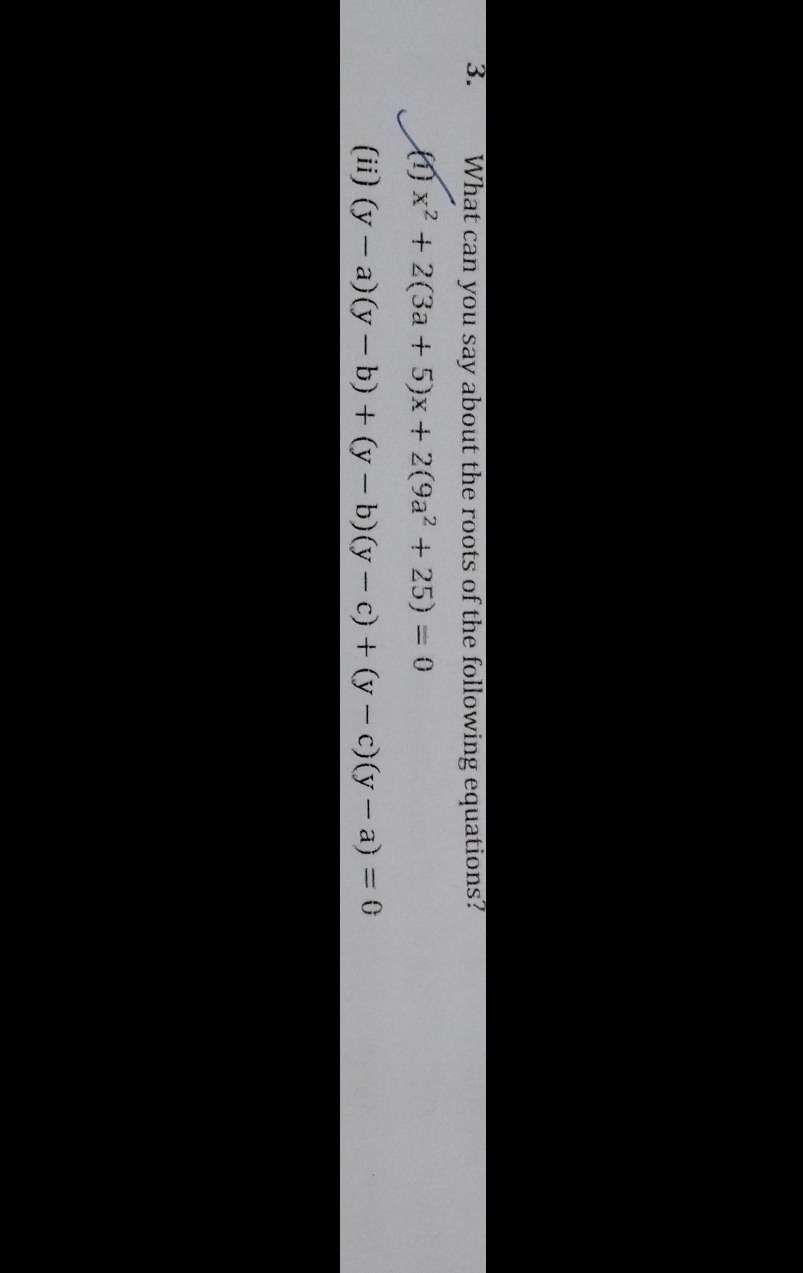Question
Question: What can you say about the roots of the following equations? (i) $x^2 + 2(3a + 5)x + 2(9a^2 + 25) =...
What can you say about the roots of the following equations?
(i) x2+2(3a+5)x+2(9a2+25)=0
(ii) (y−a)(y−b)+(y−b)(y−c)+(y−c)(y−a)=0

(i) The roots are real and equal if a=5/3, non-real otherwise. (ii) The roots are always real, equal if a=b=c, distinct otherwise.
Solution
The nature of the roots of a quadratic equation Ax2+Bx+C=0 is determined by its discriminant, Δ=B2−4AC.
- If Δ>0, the roots are real and distinct.
- If Δ=0, the roots are real and equal.
- If Δ<0, the roots are non-real (complex conjugate).
- If Δ≥0, the roots are real.
Let's analyze each equation:
(i) x2+2(3a+5)x+2(9a2+25)=0
This is a quadratic equation in x with A=1, B=2(3a+5), and C=2(9a2+25). The discriminant is Δ1=B2−4AC.
Δ1=[2(3a+5)]2−4(1)[2(9a2+25)]
Δ1=4(3a+5)2−8(9a2+25)
Δ1=4(9a2+30a+25)−72a2−200
Δ1=36a2+120a+100−72a2−200
Δ1=−36a2+120a−100
Factor out -4:
Δ1=−4(9a2−30a+25)
Recognize the perfect square trinomial 9a2−30a+25=(3a)2−2(3a)(5)+52=(3a−5)2.
So, Δ1=−4(3a−5)2.
Since (3a−5)2≥0 for any real value of a, the discriminant Δ1=−4(3a−5)2≤0.
- If Δ1=0, the roots are real and equal. This occurs when (3a−5)2=0, which means 3a−5=0, or a=5/3.
- If Δ1<0, the roots are non-real (complex conjugate). This occurs when (3a−5)2>0, which means 3a−5=0, or a=5/3.
Conclusion for (i): The roots are real and equal if a=5/3, and non-real (complex) if a=5/3.
(ii) (y−a)(y−b)+(y−b)(y−c)+(y−c)(y−a)=0
Expand the terms:
(y2−by−ay+ab)+(y2−cy−by+bc)+(y2−ay−cy+ca)=0
Combine like terms:
(y2+y2+y2)+(−ay−by−by−cy−cy−ay)+(ab+bc+ca)=0
3y2−2(a+b+c)y+(ab+bc+ca)=0
This is a quadratic equation in y with A=3, B=−2(a+b+c), and C=ab+bc+ca. The discriminant is Δ2=B2−4AC.
Δ2=[−2(a+b+c)]2−4(3)(ab+bc+ca)
Δ2=4(a+b+c)2−12(ab+bc+ca)
Δ2=4(a2+b2+c2+2ab+2bc+2ca)−12(ab+bc+ca)
Δ2=4a2+4b2+4c2+8ab+8bc+8ca−12ab−12bc−12ca
Δ2=4a2+4b2+4c2−4ab−4bc−4ca
Factor out 2:
Δ2=2(2a2+2b2+2c2−2ab−2bc−2ca)
Rearrange the terms inside the parenthesis:
Δ2=2[(a2−2ab+b2)+(b2−2bc+c2)+(c2−2ca+a2)]
Δ2=2[(a−b)2+(b−c)2+(c−a)2].
Since (a−b)2≥0, (b−c)2≥0, and (c−a)2≥0 for any real values of a,b,c, their sum is non-negative: (a−b)2+(b−c)2+(c−a)2≥0. Therefore, the discriminant Δ2=2[(a−b)2+(b−c)2+(c−a)2]≥0. Since Δ2≥0, the roots are always real.
- If Δ2=0, the roots are real and equal. This occurs when (a−b)2+(b−c)2+(c−a)2=0, which happens if and only if a−b=0, b−c=0, and c−a=0, i.e., a=b=c.
- If Δ2>0, the roots are real and distinct. This occurs when (a−b)2+(b−c)2+(c−a)2>0, which happens if a,b,c are not all equal.
Conclusion for (ii): The roots are always real. They are real and equal if a=b=c, and real and distinct if a,b,c are not all equal.
